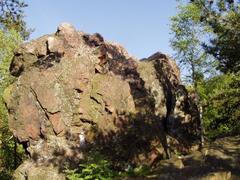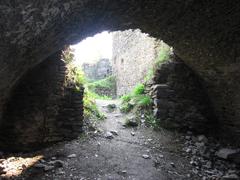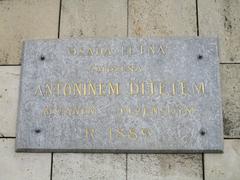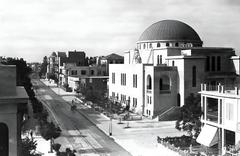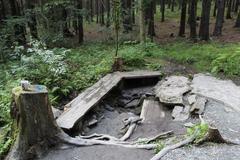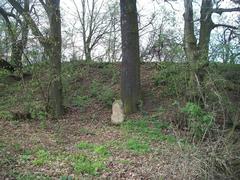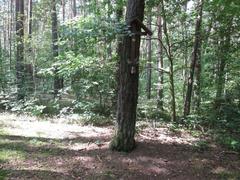Visiting Guide to Přírodní Památka Malochova Skalka in Plzeň
Date: 01/08/2024
Introduction
Nestled on the left bank of the Berounka River near the village of Druztová in the Plzeň-sever district, Přírodní Památka Malochova Skalka is a natural monument that offers visitors a rich tapestry of history, geological wonder, and biodiversity. Declared a protected area in 1970, the preservation efforts for this site actually date back to the late 19th century. The Plzeň branch of the Czech Tourist Club, founded in 1892, was instrumental in promoting the area’s natural beauty and accessibility (ozp.plzen.eu). The region’s geological composition, featuring spilites, sandstones, and shales, creates an extraordinary landscape that supports a diverse range of plant and animal species. From its historical significance to its vibrant ecological diversity, Malochova Skalka is a treasure trove for nature enthusiasts and history buffs alike. This guide aims to provide comprehensive information on visiting this unique site, including practical travel tips, details about its ecological importance, and nearby attractions.
Table of Contents
- Introduction
- History and Significance
- Visitor Information
- Ecological Importance
- Biodiversity
- Conservation Efforts
- Recreational and Educational Value
- Nearby Attractions
- FAQ
- Conclusion
History and Significance
Historical Background
Malochova Skalka was declared a protected area in 1970. However, the region’s conservation efforts date back to the late 19th century with the establishment of the Plzeň branch of the Czech Tourist Club on December 15, 1892. This organization was pivotal in promoting the area’s natural beauty and accessibility by creating the yellow-marked tourist path around Háj above the river in 1893 (ozp.plzen.eu).
Geological Significance
The geological composition of Malochova Skalka includes hard spilites, sandstones, and shales, with the Berounka River canyon reaching depths of approximately 35 meters. The adjacent plateaus contain Tertiary gravel sands, while the steep slopes reveal outcrops of Proterozoic bedrock. This diverse geological structure supports a variety of soil types and plant communities (ozp.plzen.eu).
Visitor Information
Tickets and Visiting Hours
Malochova Skalka is open year-round, offering free access to visitors. While there is no ticket required to explore the natural monument, donations towards conservation efforts are welcomed.
Travel Tips
- Best Time to Visit: Spring and autumn offer the most pleasant weather and vibrant natural scenery.
- Getting There: The site is accessible by car or public transportation from Plzeň. Parking is available near the entrance.
- Guided Tours: While there are no official guided tours, local guides can be hired for an in-depth exploration.
Ecological Importance
The primary goal of protecting Malochova Skalka is to preserve its ecologically stable and harmonious environment, which boasts significant scientific and aesthetic values. The area serves as a refuge for numerous plant and animal species, some of which are rare or endangered. Notable vegetation includes natural scree forests, oak-hornbeam groves, and semi-cultivated meadows (ozp.plzen.eu).
Biodiversity
Malochova Skalka is home to diverse plant communities, from natural outcrops of spilitic rocks to species-rich meadows and riparian vegetation. Notable plant species include Melica picta, Geranium sanguineum, and Lilium martagon. Animal species such as the spotted salamander, crayfish, otter, eagle owl, and heron also thrive in this environment (ozp.plzen.eu).
Conservation Efforts
Efforts at Malochova Skalka focus on maintaining ecological stability and the unique landscape character. This involves managing natural processes and recreational activities to ensure the preservation of its natural resources and environment. The area is suitable for studying ecological principles, feedback mechanisms, and the temporal dynamics of ecosystems (ozp.plzen.eu).
Recreational and Educational Value
Malochova Skalka offers various recreational opportunities, including hiking and cycling trails, marked tourist paths, and educational trails such as the Zábělá nature trail. The area is also popular for water sports on the Berounka River. The yellow-marked tourist path around Háj is the oldest tourist path in the Plzeň area (ozp.plzen.eu).
Nearby Attractions
Malochova Skalka is part of the larger Horní Berounka Nature Park, which spans a 2 km wide strip along both banks of the Berounka River. Nearby attractions include the Church of St. George in Plzeň, various hiking trails, and the scenic village of Zvíkovec.
FAQ
What are the visiting hours for Malochova Skalka?
Malochova Skalka is open year-round and can be visited at any time.
Are there guided tours available?
There are no official guided tours, but local guides can be hired for an in-depth exploration.
Is there an entrance fee for Malochova Skalka?
No, there is no entrance fee. However, donations towards conservation efforts are appreciated.
Conclusion
Malochova Skalka is a significant natural monument with a rich history of conservation efforts and a diverse range of plant and animal species. Its geological features, ecological importance, and recreational opportunities make it a valuable destination for both tourists and researchers. Ongoing conservation efforts aim to preserve its unique landscape and ecological stability, ensuring it remains a refuge for rare and endangered species and a site for scientific study and environmental education (ozp.plzen.eu).
References
- ozp.plzen.eu (n.d.). Protected Areas. Retrieved from ozp.plzen.eu
- visitplzen.eu (n.d.). Educational Path. Retrieved from visitplzen.eu
- prirodaceska.cz (n.d.). Malochova Skalka. Retrieved from prirodaceska.cz
- itras.cz (n.d.). Malochova Skalka. Retrieved from itras.cz
- zestinu.cz (2023, October 22). Plzeň Known and Unknown: Malochova Skalka. Retrieved from zestinu.cz
- cs.wikipedia.org (n.d.). Malochova Skalka. Retrieved from cs.wikipedia.org
